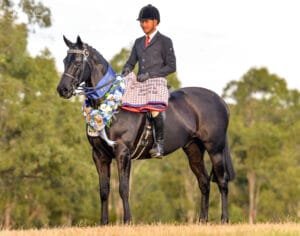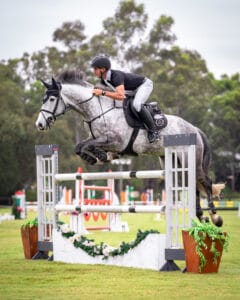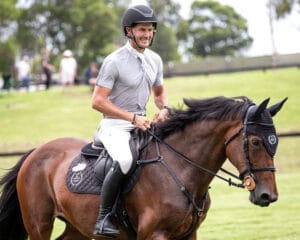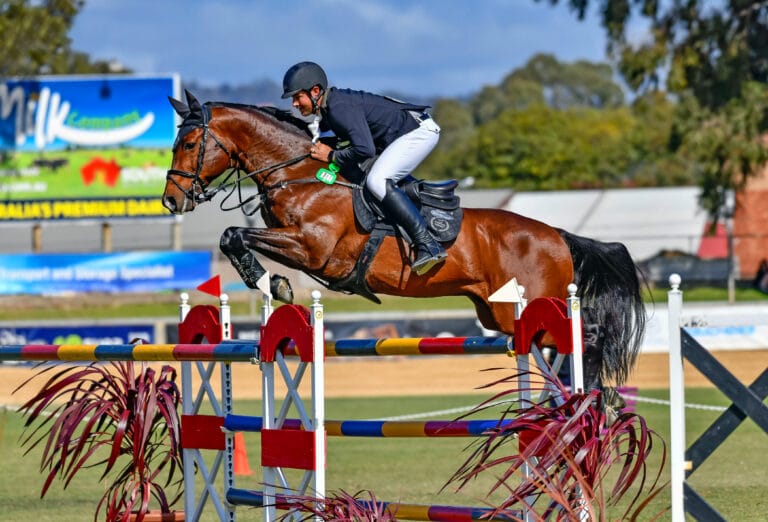Everyone has dreams, but some are more willing than others to do what’s needed to achieve them. And Rhys Stones is more than willing, as AMANDA MAC discovers.
At no time ever did the young Rhys Stones contemplate making a living from horses. “It’s really quite Ironic, isn’t it” he laughs. You could say that. In partnership with wife Jess, Rhys has grown J & R Equestrian into one of the Australian horse industry’s best recognised brands, so ‘ironic’ barely covers it.
There are not many major shows where you won’t see the big black J & R truck, rarer still for Rhys and Jess to be missing from the winners’ circle. And talk to Rhys even briefly and it becomes obvious that he and Jess are a tight knit team. They have both represented Australia internationally and produce and campaign horses of the highest quality. The success they’ve achieved they’ve achieved together through hard work and toughing out the inevitable ups and downs of business.
But back to Rhys. He tells me he was too young to remember when he first started to ride. However, with his mother’s love of all things equestrian – she owned show horses and bred Thoroughbreds and Australian Stock Horses, albeit in a relatively minor way – I’m thinking it was probably fairly early. “The first pony I do recall was Darby, a black Welsh Mountain, or perhaps a Shetland,” he muses. “I just have memories of a fat little pony that had a mane that spiked up.” We agree that Darby’s certainly sounding a lot like a Shetland.

Jess and Rhys have grown J & R Equestrian into one of Australia’s bestrecognised equestrian brands (Image by Lisa Gordon, A Little More Grace Photography).
Growing up in Rutherglen, a small town near the NSW’s border in north-eastern Victoria, meant life was reasonably laid back. Rhys, his older sister and two younger brothers all rode, and, of course, went to Pony Club. Rhys recalls his early days on horseback as a bit of a mixed basket, which included all the local shows: “As a little kid you went into the funkhana ring and the child classes, and from there I graduated to sporting and mounted games, and I did a little bit of eventing in there as well.”
Perhaps influenced by his mother’s interest in the breed, by the time he’d reached his early teens Rhys was showing Stock Horses for their owners, as well as competing in Stockman’s Challenges. Never one to do things by halves, he entered The Man from Snowy River Challenge at Corryong, and succeeded in placing second in the junior division – no small achievement. That was in 2005, which is also around the time when the then 16-year-old Rhys developed a passion for show jumping.
Another thing you quickly realise during a conversation with Rhys Stones is that he is, and it seems always has been, a strategist who gives very careful thought to the decisions he makes. By the time he left school after Year 11, he’d already ruled out becoming a professional equestrian: “The very last thing I wanted to make money out of, or even to try and make money out of was horses. I guess where I came from that was a non-event, there was simply no money in it. So I did an apprenticeship and qualified as a brick layer.”
Now, that’s not to say that he didn’t have very definite plans to pursue his love of jumping – he did, and for that reason when his apprenticeship was pretty much complete he moved north.
With the security of a trade behind him, Rhys based himself at internationally renowned eventer Simon Kale’s Foxground Training Stables two hours south of Sydney. Initially, Rhys had not intended relocating on a permanent basis, it was simply to have the opportunity to immerse himself in his sport. “I was quite lucky in that my apprenticeship was with my father. So I had some flexibility around what I did. I’d always wanted to pursue show jumping but not as a career. I wanted to have it as a pretty serious hobby, supported by another career in a different industry. So at that point the move to Sydney was for just a couple of months at a time for competitions,” he explains.
But it took no time at all for Rhys’ talent to be recognised, and in 2007 he was selected for a junior team going to the International Friendship Championships in South Africa. And that was a turning point: “Once I’d had that experience, it really made me think okay, I want to keep doing this. And then it just progressed from there.”
Now keener than ever, on his return to Australia Rhys competed at a few shows including the JK Williams, a bit of a highlight on the NSW’s equestrian calendar back in the day. And that’s where he first met Jess Stalling: “I was 17 at the time and not long after that she went over to Europe for a couple of months and I ended up going back home.”
Unfortunately, in August 2007 equine influenza struck, bringing equestrian events in Australia to a standstill. It wasn’t until Rhys was eventually able to return to Sydney in 2008 that he and Jess reconnected at the New South Wales Youth Titles in Nowra. And that was pretty much it. “I don’t think I really went back home much after that,” he says. Surely not a surprise!

Rhys and Taittinger,Arrowfield Stud Large HackChampionat the Elizabeth FarmHOTYShow (Image by Lisa Gordon, A Little More Grace Photography).
When I ask Rhys how his career progressed from that point, he apologises for being a little bit vague on the details, but that has a lot to do with his take on life: “I’m not really one for remembering the past. I’m always looking forward to the future, that’s just what I do.”
Nevertheless, he tells me that although he’s never really purchased an established jumper, he and Jess have produced a number of World Cup horses from scratch. “I’ve won an Australian State Championship, a New South Wales State Futurity title, and numerous World Cup placings. I haven’t actually won a World Cup yet, that’s still evading me unfortunately,” he says. Time will tell whether that elusiveness lasts.
There are several names that Rhys rates among his better horses. Oaks Altador, who he purchased as a yearling in 2009 and broke in the following year, was Leading Young horse at the Adelaide Royal in 2013 and 2015, won three Australian Speed Championships, and in 2016 was the AQUIS Gold Cup Grand Prix Champion.
However, Altador did have her quirks. Exceptionally shy of other horses, she woulddo anything to avoid them, making her warm up at shows something of a challenge. Her idiosyncrasies also caused Rhys to have three major falls, not to mention an assortment of broken bones. Meanwhile Jess, who rode her for a win in one of the mare’s first shows, the Four Year Old Class at the SIEC Sydney Summer Classic Young Horse Finals, came home vowing never to ride Rhys’ “crazy” horse ever again!
But quirks aside, Altador shone in a number of Royal Show Part 2 and Part 3 classes, as well as multiple Grand Prix and Mini Prix. “She was a very successful horse,” Rhys recalls, “but unfortunately, her career was cut short with a paddock accident when she fractured her fetlock as an eight-year-old just after winning the AQUIS Gold Cup at Elysian Fields.”
Also on Rhys’ ‘best of’ list is the then Stones family owned BS On Air, who was second in the 2014 Brisbane Royal World Cup (to date, the closest Rhys has come to ticking that particular box), placed at Gawler in the same year, and did well in Part 1 and Part 2 classes at a number of Royal Shows.
Then there’s the 2018 Australian Mini Prix Champion Tulara Colmar with whom Rhys qualified for Tokyo after picking up a half Minimum Eligibility Requirement (MER) in the 2019 Adelaide World Cup, and upgrading to a full MER at Sale. Securing the MER required two clear rounds in two separate World Cup classes, which, Rhys reckons was a bit of an achievement for both man and horse. “Jess and I produced Tulara. My mother actually bought him as a weanling, so we had him for the whole journey. But he wasn’t the horse for the Games and I knew that so I didn’t pursue it. But yeah, I was very happy with what we’d achieved and I eventually sold him last year. There was also RS Crescendo in there, another one that I World Cupped for a while, and I did a couple of World Cups with Diamond B Vermont – so I’ve had four World Cup horses so far.” Not a bad result for someone who doesn’t buy established horses.
From a business perspective, selling Tulara Colmar was absolutely the right decision, but it did leave Rhys vulnerable in that he no longer had a Grand Prix horse. Fortunately, two client horses filled the gap for a time but when they eventually returned to their owners, it prompted Rhys to buy MVNZ Othello.

Competing with Othello at Waratah Showjumping in January this year (Image bySimon Scully Photography).
Imported from New Zealand as a three-year-old, Othello was initially with a Young Rider in Central Victoria. But when the state went into lockdown, the horse was sent to J & R Equestrian to be sold. Rhys took him to a couple of small events before a good friend came to try him out. “I was standing there watching and I’m thinking ‘this horse is not getting sold. I’m buying it’. And thanks to my friend for showing me what I don’t want to get rid of!” he laughs.
Part of the now seven-year-old Othello’s appeal, Rhys says, is that he’s a very rideable horse, and very rideable equates to very saleable: “That was the main driver behind me buying him, he was a good commercial proposition. He is also a very cool horse, very nice to watch and he wants to do his job. I’m quite confident that I’ll be taking him to Grand Prix either this year or next.”
Show jumping is not Rhys’ only forte. He’s had his fair share of show ring successes too. However, you can’t help but wonder, after the adrenalin fuelled sport of jumping, and qualifying for the Olympics, how easy it is to make the transition back into showing. But ever down to earth, he assures me it’s not that difficult: “I’ve been up and down with horses my whole career. I get a good horse and then it either gets sold or breaks down, and usually I’ve got another one on the way up. So it’s a journey. I feel like I’m just getting older and riding different horses, because producing jumping horses to Grand Prix is a seven, eight year commitment.”
And then there’s the other side of the coin: Rhys and Jess’ now thriving J & R Equestrian, a business they started around 10 years ago. After moving several times, the couple, who married in 2016, eventually bought a property at The Oaks, some 80 kilometres south west of Sydney, where they plan to stay until they retire. To complete the picture, the smallest member of the J & R team, their delightful daughter Eva, arrived three years ago.
A major component of their business lies in the show ring. Jess has built an outstanding career as a successful show rider, winning just about everything there is to win including the much coveted Garryowen. “I’m quite honestly able to say that if it weren’t for Jess, I would not be in the picture with show horses myself,” Rhys tells me, “but I’ve supported and will continue to support Jess in the show ring for as long as needs be. She’s great at what she does and it’s a great business we’ve created. We’ve got fantastic long term clients with great horses, and that’s really the enjoyment of it.”
While all of this may sound a little like a fairy tale, don’t be fooled – the going has been far from easy. Ask Rhys what the biggest challenge has been, and he’s emphatic: “It’s the financial struggle. I think the key to J & R Equestrian’s success is diversity. We are cross discipline in everything we do and we work hard.”
Prior to where the couple now sit with their business they both had outside jobs, at one stage riding track work. Rhys went back to bricklaying for several years just to make ends meet – because, as he points out, there was no other choice: “If you rely solely on inconsistent business when you’re trying to build your name and brand, you’ll quickly lose out on it unless you’ve got financial support from somebody else.”
But the Stones are both fiercely independent, so relying on others has never been an option – and with no free rides, complete commitment was crucial if they were to succeed. “We had to do what we had to do,” Rhys says. “There were many years when I’d be away all week laying bricks. I’d arrive home late on Friday evening, be up at four o’clock on Saturday and Sunday mornings to go to shows, and then have to be in bed by eight o’clock on Sunday night so I could get up at two in the morning to go to work. You have to stick it out and be committed to what you want, and make ends meet however you need to.”
And the pressure certainly didn’t let up after buying The Oaks. “We’ve been here now for eight years. Jess has always been predominantly full time, but I was very indecisive about whether we could make a go of it without having to push Jess hard to generate income. I’d support her at any cost and it was getting to a point where I didn’t want her to have to ride so many horses,” Rhys explains.
So it was back to another stint of bricklaying. But around four years ago, J & R Equestrian had grown to the point where Rhys finally made the decision to down tools and immerse himself in the business: “I would say my full time job is breaking in horses. And that’s across all disciplines and breeds, from showing and dressage to show jumping and pleasure, and anything from ponies to Thoroughbreds to Warmbloods. We even did a Shire last month. That’s my role in the industry at the moment, breaking in and producing young horses.”
It’s taken a long time to build their now considerable reputation, but their perseverance has paid off. From breaking in two horses a month, now it’s up to ten, a dramatic increase by anyone’s standards. With between 35 to 40 horses on their property, and nearly all of them in work, life is hectic and there’s pressure, lots of pressure, which fortunately Rhys and Jess thrive on. They usually have three full-time staff to help carry the load, but the couple produce and ride all of their clients’ horses themselves. “We’ve got one other girl, Tahli Hendlerand, who rides the horses that we own. She works all the jumpers and Jess and I’ll give them a jump once or twice a week.”

Rhys and Riverton Kanntador, an upcoming J & R youngster sired by Kannanout of Oaks Altador (Image by Simon Scully Photography).
And speaking of jumpers, other than Othello, there are 22 horses under four years of age in the pipeline, with 10 on the truck to go jumping. Plenty of World Cup candidates in the making there, you’d imagine.
Now with their business well set up, I wonder what their plans are going forward. Initially, Rhys’ response surprises me. But when I think about it, it’s absolutely in line with his pragmatic approach: “Well obviously I’m very business driven, very business focused, and the main thing for me is investments, making hay while the sun shines as they say. To be absolutely honest, the goals I mostly think of are not in the horse industry. They’re around building a real estate portfolio for my family. That’s probably my highest priority.”
The couple have an investment property in Wodonga, and The Oaks certainly hasn’t gone backwards in value over the past 18 months. So it looks like things are nicely on track, which, given Rhys’ dream of retiring to the Byron Bay hinterland by the time he’s 40, is a big plus.
Other than real estate, Rhys still has his eye on that elusive World Cup, and he’s pretty confident that Othello is the one to take him there, always assuming that the horse isn’t sold beforehand. With regards the show ring, he has no goals. He’s content to continue supporting Jess in what she does. “And that’s the business focussed side of us,” he says. “We do it because Jess is great at doing it and we love working with the horses. That’s the other driver behind showing, we just love working with nice horses. At the end of the day, the show ring goals aren’t personal so much as they are about setting objectives for each individual horse.”
I ask Rhys whether he’s ever had any regrets around putting down his brick layer’s tools to move in the direction he has: “No, none whatsoever. I just had to wait for the right time.”
Clearly, the benefits of being a strategist are many.
Feature image: With Tulara Colmarin theWorld Cup jump offat the2019 Adelaide Royal (Imageby Lisa Gordon, A Little More Grace Photography)



